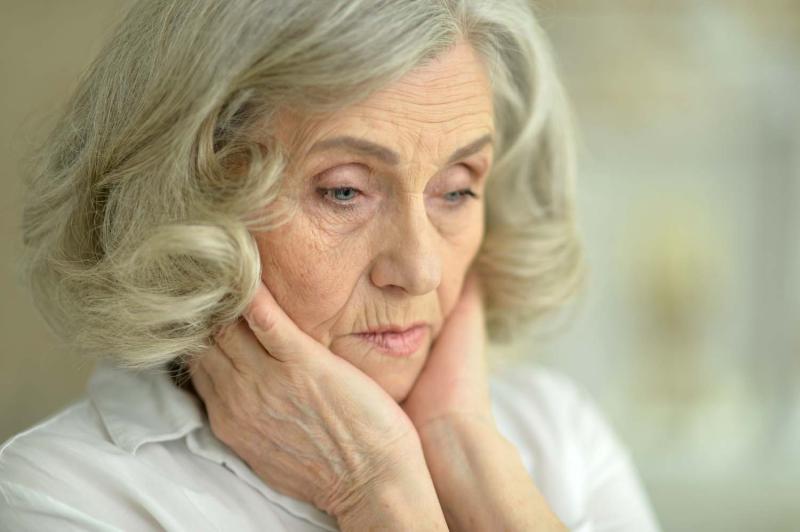Key points
- In Australia, approximately 10 per cent of older adults have anxiety.
- Anxiety disorders are especially prevalent among people living in residential aged care.
- Multiple factors can increase the likelihood of someone experiencing anxiety in residential aged care. These include medication use, cognitive and functional impairment, pain, and depression.
- Although screening tools for anxiety are available, the best way to detect anxiety among people living in residential aged care remains unclear.
- There is little evidence about what works to reduce anxiety in aged care settings.
Anxiety disorders are relatively common mental health conditions. [1] An anxiety disorder may be present when someone has excessive feelings of anxiety or fears that impact their daily life. [1] In Australia, approximately 10 per cent of older adults have anxiety. [2] Alongside depression, anxiety is one of the more frequently reported mental health conditions in older adulthood. It is also more common among people with depression. [3] Anxiety disorders are especially prevalent among people living in residential aged care, with approximately 19 per cent of residents having significant symptoms of anxiety. [4] According to Beyond Blue’s submission to the Royal Commission into Aged Care Quality and Safety, there are no regular checks in residential aged care facilities for anxiety. If anxiety is identified early, it can often be treated or managed, which can prevent worsening symptoms. [5] Furthermore, symptoms of anxiety such as palpitations or shortness of breath might be mistaken for symptoms of physical conditions commonly seen in older populations or the side effects of medications. [6]
While there is little information available to guide responses to anxiety among people living in residential aged care, even less is known about anxiety experienced by people in receipt of home care services.
This evidence theme on anxiety is a summary of one of the key topics identified by a scoping review of mental health and wellbeing research. If you need more information on this topic, try using the PubMed search below.
Although anxiety disorders are relatively common in older adulthood (especially among those living in residential aged care), we only found seven systematic reviews focused on anxiety in this population.
Risk factors for anxiety
One review examined the factors that are associated with anxiety among people living in residential aged care. [3] Overall, there are multiple factors which increase the likelihood of someone experiencing anxiety, including:
• Being younger
• Being female
• Higher use of medications (including anticholinergics, antipsychotics, and antidepressants)
• A higher level of impairment (including cognitive, functional, and visual)
• A higher level of depression
• Higher levels of pain
• A higher number of co-existing conditions (or ‘comorbidities’)
• A lower personal evaluation of one’s own health and wellbeing. [3]
Detecting anxiety among older people
One review focused on tools for detecting anxiety in residential aged care populations. [6] While a wide range of tools are available for this purpose, the authors reported that there was little research and consensus surrounding the reliability, validity, and ease of administration of these tools within this setting. The most used tools for detecting anxiety within residential aged care settings included:
• Rating Anxiety in Dementia (RAID)
• Hospital Anxiety and Depression Scale – Anxiety subscale (HADS-A)
• State-Trait Anxiety Inventory (STAI)
• Geriatric Anxiety Inventory (GAI)
The most appropriate tool for detecting anxiety in aged care settings is not yet apparent with those commonly used still requiring validation for use with this population. [6] However, according to the review authors, the strongest evidence of reliability and validity was found for the Geriatric Anxiety Inventory. [6] The topic of mental health screening tools in aged care is covered in more detail in a separate theme.
Five reviews focused on non-pharmacological interventions to improve mental health outcomes including anxiety.
Reminiscence therapy
Three reviews examined whether reminiscence therapy was effective in reducing anxiety in older adults. [7] One of these reviews found that spiritual reminiscence therapy (defined as a review of the person’s full lifespan that involves individuals trying to find the meaning of their life and their future hopes) did not significantly reduce anxiety levels of residents. [7] The second review found that a reminiscence program combined with music (particularly religious songs) was successful in reducing anxiety symptoms. [8] The third review reported that reminiscence therapy did not appear to be effective in treating anxiety among people living in residential aged care. [9]
Psychosocial interventions
Another review focused on psychosocial interventions to reduce depression and anxiety among older Chinese adults. [10] These interventions included approaches such as individualised learning therapy, cognitive behavioural therapy, problem-solving therapy, reminiscence therapy, and relaxation therapy. While the results of each individual study were not made clear in the review, the review concluded overall that these approaches were generally effective in reducing anxiety. [10] In fact, the review authors stated that psychosocial interventions were more effective in reducing anxiety than they were in reducing depression. [10]
Cognitive behavioural therapy
Two reviews focused on cognitive behavioural therapy for the treatment of anxiety among people living in residential aged care. [9, 11] Cognitive behavioural therapy is a psychotherapeutic approach which supports individuals to learn structured problem-solving skills. According to one review, there was inconsistent evidence that cognitive behavioural interventions can reduce anxiety among residents. This is because some studies reported benefits of the approach, while others did not. [11] A second review reported that cognitive behavioural therapy was generally effective at reducing anxiety among residents. [9]
Other approaches
A recent systematic review reported that music-based interventions, psychotherapy, massage, and therapeutic touch interventions were effective in reducing anxiety. However, exercise, multicomponent interventions, and the use of robotic animals and lifelike dolls were not effective in reducing anxiety among residents. [9]
Reviews highlighted concerns about the methods used in some of the studies. This reduces the degree of certainty we might have about what works to reduce anxiety in older adults. For example:
- What the intervention involved was often unclear. [7, 10]
- How the intervention was conducted was quite different across studies, making it difficult to determine the overall impact of specific interventions. [9]
- In some studies, it was unclear whether participants had a diagnosis of anxiety or not. [11]
- Many studies were focused on people without a diagnosis of anxiety, so it was often unclear how these approaches might work for people who are diagnosed with the condition. [9]
- Some studies only had a small number of participants. [7, 9]
- The long-term effects of the interventions were often not measured or reported. [7]
- Relatively few studies have examined the issue of anxiety in older adults, despite it being an important consideration for this group of people and their families.
- Only one systematic review focused on anxiety as an outcome on its own. [9] The remaining reviews assessed anxiety as one of multiple wellbeing outcomes such as loneliness and depression. More research in this field is needed.
- Gain more knowledge around signs of anxiety.
- Learn more about how to approach a conversation about mental health with someone you may be worried about. See resources below.
- Refer or escalate concerns you may have about the psychological wellbeing of an individual to a supervisor or manager.
- Provide routine mental health checks for people in its care.
- Consider employing or contracting someone with psychological expertise into the organisation.
- Provide regular staff training about recognising and responding to mental health concerns among the people they support.
- Implement regular case conferences for individuals who have mental health conditions or for whom staff have concerns. The individual and their family should also be involved.
- Support and encourage staff to approach management with any concerns about individuals’ psychological wellbeing.
- BetterHealth Channel. Anxiety disorders [Internet]. 2020 [cited 2023 Jun 29]. Available from: https://www.betterhealth.vic.gov.au/health/conditionsandtreatments/anxiety-disorders.
- Beyond Blue. Our work with older adults [Internet]. n.d. [cited 2023 Jun 29]. Available from: https://www.beyondblue.org.au/about-us/about-our-work/older-adults-program.
- Creighton AS, Davison TE, Kissane DW. The correlates of anxiety among older adults in nursing homes and other residential aged care facilities: A systematic review. Int J Geriatr Psychiatry. 2017;32(2):141-54.
- Creighton AS, Davison TE, Kissane DW. The prevalence, reporting, and treatment of anxiety among older adults in nursing homes and other residential aged care facilities. J Affect Disord. 2018;227:416-23.
- National Ageing Research Institute. Healthy ageing literature review: Final report to the Department of Health and Human Services. Victorian Government: Melbourne; 2016.
- Creighton AS, Davison TE, Kissane DW. The assessment of anxiety in aged care residents: A systematic review of the psychometric properties of commonly used measures. Int Psychogeriatr. 2018;30(7):967-79.
- Syed Elias SM, Neville C, Scott T. The effectiveness of group reminiscence therapy for loneliness, anxiety and depression in older adults in long-term care: A systematic review. J Geriatr Nurs. 2015;36(5):372-80.
- Istvandity L. Combining music and reminiscence therapy interventions for wellbeing in elderly populations: A systematic review. Complement Ther Clin Pract. 2017;28:18-25.
- Atchison K, Watt JA, Ewert D, Toohey AM, Ismail Z, Goodarzi Z. Non-pharmacologic and pharmacologic treatments for anxiety in long-term care: A systematic review and meta-analysis. Age Ageing. 2022;51(9):afac195.
- Zhang A, Kong D, Jiang L, Sun F, Dunkle RE, Liu C. Understanding the effectiveness of psychosocial services for anxiety and depression in Chinese older adults: A systematic review and meta-analysis of controlled trials. Gerontologist. 2020;60(1):e76-e92.
- Chan P, Bhar S, Davison TE, Doyle C, Knight BG, Koder D, et al. Characteristics and effectiveness of cognitive behavioral therapy for older adults living in residential care: A systematic review. Aging Ment Health. 2021;25(2):187-205.
Connect to PubMed evidence
This PubMed topic search is limited to home care and residential aged care settings. You can choose to view all citations or citations to articles available free of charge.


